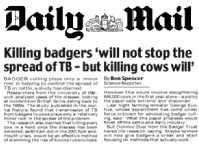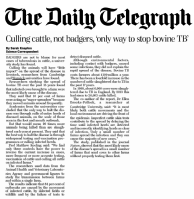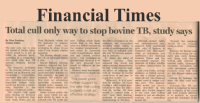News
"A dynamic model of bovine tuberculosis spread and control in Great Britain", by Ellen Brooks Pollock, Gareth Roberts and Matt Keeling, published in Nature Wednesday 2nd July.
Our over-view of this work
This work was begun in 2008 and follows on from other successful research at Warwick and Cambridge on both bovine TB and modelling livestock infections. This is the first time that anyone has developed a mechanistic mathematical national-scale model for the spread of bovine TB that accounts for multiple routes of transmission and allows us to test the impact of different controls.
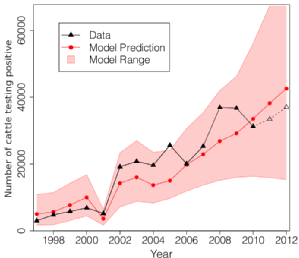 Our model shows that transmission is complex and multifaceted – with cattle-to-cattle transmission, failure to detect infection, movement of infected animals and transmission from the environment all playing a role. We believe it is this complexity that continues to fuel scientific and public debate about bovine TB.
Our model shows that transmission is complex and multifaceted – with cattle-to-cattle transmission, failure to detect infection, movement of infected animals and transmission from the environment all playing a role. We believe it is this complexity that continues to fuel scientific and public debate about bovine TB.
Looking to the future, without major changes in policy we expect the historical 10% rise in cases per year to continue. Only 3 of our tested measures were sufficient to overturn this increase:
- Additional testing in one year initially identifies more cases (as we only find bTB when we look for it), but over time the total number of detected cases reduces. A similar effect can be gained if we had more efficient test.
- Vaccination of cattle, which slows disease progression, also has a marked impact on cases; but the vaccine is currently unlicensed and would be against EU legislation.
- Culling all cattle on infected farms would rapidly bring the epidemic under control as it removes infected but undetected animals, however this leads to many more cattle being slaughtered in the first years.
All three of these measures have associated economic costs and benefits, which the government, the livestock industry and the general public must assess to decide the correct course of action. What we have presented in our paper are the predictions of a model based on the current understanding of this infection and the latest data, which we hope can help to inform decisions.
With further funding the research could be pushed in two main directions: with additional expertise we would like perform a formal cost-benefit analysis of the control measures to determine the economically best strategy; we would also like to refine and assess mixtures of control measures focused on different types of farm or different regions to determine if there is a more targeted approach to control.
What does this work say about badgers and the badger cull?
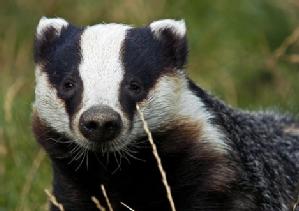 Due to the lack of detailed data, our model does not explicitly include badgers (cattle are ear-tagged and their movements recorded, the same can’t be done for wildlife). Instead we model the combined environmental reservoir, which includes infected pasture and infection in wildlife species, but cannot separate them.
Due to the lack of detailed data, our model does not explicitly include badgers (cattle are ear-tagged and their movements recorded, the same can’t be done for wildlife). Instead we model the combined environmental reservoir, which includes infected pasture and infection in wildlife species, but cannot separate them.
Clearly badger-culling is the hot topic of the moment, but we need to separate this into two distinct questions. Firstly is the recent Badger Culling Trial necessary; secondly would culling badgers help with control.
The recent Badger Culling Trial is not about control; it is about whether badgers can be culled in a humane manner. This is not something that relates to our study.
Due to the lack of detailed data, our model does not explicitly include badgers; cattle are ear-tagged and their movements recorded, the same can’t be done for wildlife and it is only very recently that any measures of badger density have been published. Additionally, while we know about cattle that test positive for bTB, again have only limited data on infection in badgers.
Instead our model has an environmental component that amalgamates both infection from wildlife, infection from contaminated pasture and any other sources beyond the farm. Given we only have data on cattle it is impossible to separate these elements -- we cannot say how much of this environmental component is due to badgers.
What we can say is about the relatively limited impact of the environmental component. We predict (Figure 2b of the Nature paper) that removing the environmental component completely would only prevent 15% of herd break-downs (when animals test positive on a farm that is not under movement retrictions). In addition, looking at figure 3 of the paper, we predict that even if the level of environmental transmission between farms was halved this would have a limited impact on bTB, slowing but not stopping the annual rise. These findings are in-line with those from the Randomised Badger Culling Trial, yet derived from different methods and data.
Do we have any suggestions for the future?
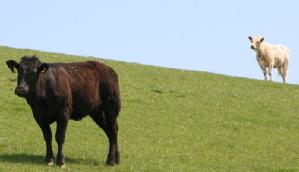 We would like to stress that we are not (and have never) advocated any one policy -- and in particular we are not advocating whole-herd culling as a viable national policy. We have conducted a simple scientific experiment that has looked at some extreme control measures in an attempt to understand the spread of bTB. In contrast, Defra & policy-makers need to deal with economic, political, legal and social aspects in addition to scientific predictions. We are highly committed to science informing policy, but realise that it is only one element.
We would like to stress that we are not (and have never) advocated any one policy -- and in particular we are not advocating whole-herd culling as a viable national policy. We have conducted a simple scientific experiment that has looked at some extreme control measures in an attempt to understand the spread of bTB. In contrast, Defra & policy-makers need to deal with economic, political, legal and social aspects in addition to scientific predictions. We are highly committed to science informing policy, but realise that it is only one element.
From the results of our model, the recent changes to testing (that started in 2013) would appear to be a positive step. However, we feel this is unlikely to sufficient to completely control the infection; however its too early, with too little data, to make definitive predictions.
If we had to suggest further action for policy-makers, from our standpoint it would be good to have clearly defined strategic goals with appropriate costs and benefits (ie how much would the UK value being bTB-free). For example NICE (who deal with medical treatments) and JCVI (who deal with vaccination in humans) have specific cost-benefit guidelines, and predictive models help to inform policy decisions. A similar set of precisely defined goals agreed by all interested parties would allow models such as ours to interface better with policy requirements.
It is also important that we realise that bTB is a long-term problem with no quick solutions available with current technology. Erradication campaigns are likely to take decades.
What other scientists are saying about this work (from Science Media Centre)
Prof Rosie Woodroffe, Institute of Zoology, Zoological Society of London (ZSL), said:
“Cattle TB is a terrible problem for farmers in the UK, and its control continues to present major challenges. This new research is thought-provoking and potentially very important for informing decisions about TB control. Like all models, it’s a simplification of reality, but it raises a number of interesting questions which merit further exploration.
“A particularly interesting finding relates to the importance of infection from the environment; this includes a number of environmental sources including badgers, contamination of the farm environment, and possibly other wild or domestic animals. The model suggests that this environmental source on its own is responsible for just 15% of herd infections. While this finding needs to be interpreted with caution, it does echo the findings of a model by Donnelly & Nouvellet which suggested that 6% (and a maximum of 25%) of new herd incidents in cattle were caused by direct transmission from badgers to cattle.
“While perhaps not a major cause of cattle on its own, this environmental effect is found to contribute to 68% of infections when in combination with factors relating to cattle management. What is surprising is that this environmental source appears to decay rapidly (with a half-life of 34 days). The rapidity of this decay resembles the rate of decay of M. bovis in the environment, and suggests that physical contamination of the environment might potentially be a more important source of cattle infection than previously assumed. Were infection from badgers a major source of new infections in cattle, one would expect a much slower decay of the infection in the environment – on a scale of years rather than days. Further investigations of the role of environmental contamination on cattle TB risks would be warranted.
“One of the paper’s conclusions is that a 50% reduction in this local environmental TB risk – intended to simulate large-scale badger culling – is predicted to be insufficient to prevent the continued spread of cattle TB. This finding is important given the massive cost, effort and controversy associated with badger culling. While eradicating TB in cattle in the long term is likely to require efforts to target infection in badgers, this paper predicts that controlling TB in the short and medium term would be more effectively achieved by management targeted at cattle.”
Prof Robbie McDonald of the University of Exeter’s Environment and Sustainability Institute, writing in Nature's News and Views, said:
“Brooks-Pollock and colleagues’ complex modelling approach provides two simple messages: first, that direct, generic controls imposed on cattle provide the greatest leverage for acting on the current mass of the bTB epidemic; and second, that although the environment is an important source of infection, indirectly tackling cattle disease by managing wildlife, by whatever means, is likely to yield unimpressive results and contribute little biologically to controlling a national epidemic.
“Although their work is compelling, the authors’ job is not complete. Policymakers often speak of their use of a “package of measures” and “every tool in the box” in controlling bTB, particularly with respect to controversial policies to cull badgers. Measures aimed at wildlife could contribute to bTB control in Britain, perhaps as part of achieving consensus among stakeholders in conflict or, most importantly, in the eventual transition from control to eradication of infection. But having shown that individual strategies, short of draconian whole-herd culling, will not rapidly turn this epidemic around, Brooks-Pollock et al. now have the perfect opportunity to use their model to test policymakers’ expectations of their various packages and tool-boxes and to gauge their overall cost-effectiveness. UK governments and the farming industry badly need such guidance to frame and implement their overall strategy and to manage expectations among their diverse stakeholders.
“This model highlights the scale of the challenge involved in controlling the bovine TB epidemic. The model suggests that slaughtering the whole herd upon detection of bTB would result, in the year after implementation, in drastic reductions in the number of cattle testing positive for bTB and in removal of restrictions from much of the national herd. However, this is a silver bullet that would cause severe wounding to the cattle industry, because it would come at the cost of a one-off, 20-fold increase in cattle slaughtered in the first year of the policy. Such a cost is reminiscent of the catastrophic scale of Britain’s 2001 experience of controlling foot and mouth disease and is likely to be horrifying to policymakers, farmers and animal-welfare campaigners alike.”
Prof Ian Boyd, Defra Chief Scientific Advisor, said:
“The study confirms the immense complexity of bovine tuberculosis and the challenges there are with bringing the disease under control. It makes some simplifying assumptions, especially about the role of badgers, and this may compromise the predictions so the results need to be interpreted with care.
“Based on our current understanding of the disease cycle, the more severe control measures suggested by the paper would probably result in a rapid decline in the cattle industry in areas where TB occurs. However, the study reinforces the basis of the current TB control strategy which is designed to cope with complex and diverse routes of infection.”
Lord John Krebs, Principal of Jesus College, and Professor of Zoology, University of Oxford, said:
“The sophisticated model and conclusions described in this paper give further support to the view that culling badgers is not an effective strategy for controlling bovine TB. Instead the emphasis should be on stopping cattle-to-cattle transmission. It is to be hoped that Defra takes on board this latest piece of scientific evidence when they formulate their policy for the future.”
Prof Kevin McConway, Professor of Applied Statistics, The Open University, said:
“This study involves building a statistical model, and using it to make some predictions about the effect of possible interventions aimed at controlling bovine TB. As with any statistical model, you've got to bear in mind that the model can't be a full description of real life, and in the real world things might not develop precisely as the model says they will. But, that said, in my view the modelling is state-of-the art and predictions from it are very likely to be useful. The model is informed by considerable amounts of data on real cattle herds, has been constructed by experts, and uses appropriate advanced modelling techniques.
“The model doesn't pick apart the exact details of how cattle might be infected from environmental sources such as badgers or infected pastures. But its key prediction is that dealing with just one aspect of TB transmission, whether it's a major badger cull or much greater restrictions on cattle movement, is unlikely to have a major effect on its own. The authors do suggest that some more drastic interventions would have an effect, such as large increases in the amount of TB testing in cattle, or even culling whole herds when infected cattle are found. But it seems clear that there's no simple solution to this problem.”
George Eustice, Farming Minister, said:
“We cannot accept the paper’s findings because it does not investigate the full range of ways in which TB could spread. What this paper proposes would finish off the cattle and dairy industry in this country.“TB is devastating for our dairy and cattle farmers and, along with blanket testing and removal of infected cattle, biosecurity measures, vaccination and cattle movement controls, culls will help get this disease under control.”
What the press is saying about this work.
|
Badger cull 'won't control bovine TB'. Midlands Today Whats the best way to tackle bovine TB. The Guardian Research suggests culling badger not effective to stop spread of bovine TB. RTE Tuberculosis threat requires mass cull of cattle, not badgers, study reveals. The Guardian New bovine TB study throws Goverment badger culling policy in to doubt. Western Morning News First national model for bovine TB calls for more focus on cattle. Science Codex Defra dismisses research questioning merits of badger cull Farmers Guardian - Scientists back whole-herd slaughter to cut TB FarmersWeekly Radical plan needed to stop spread of cattle TB - study BBC News Total cull 'necessary' to prevent spread of bovine TB in UK Financial Times Kill cattle not badgers to halt UK's TB epidemic. New Scientist National Model for Bovine TB Calls for More Focus on Cattle. Stackyard Culling badgers is no way to stop the spread of bovine TB. The Ecologist. |

